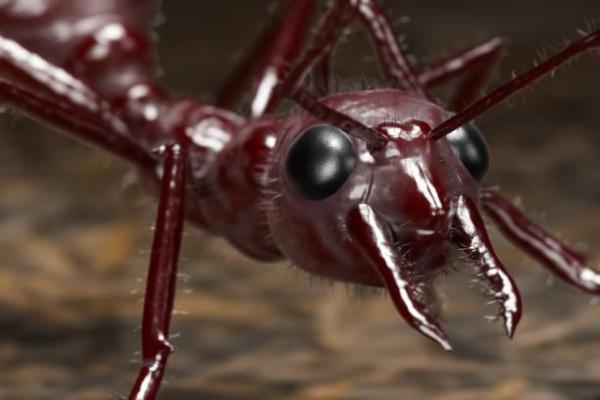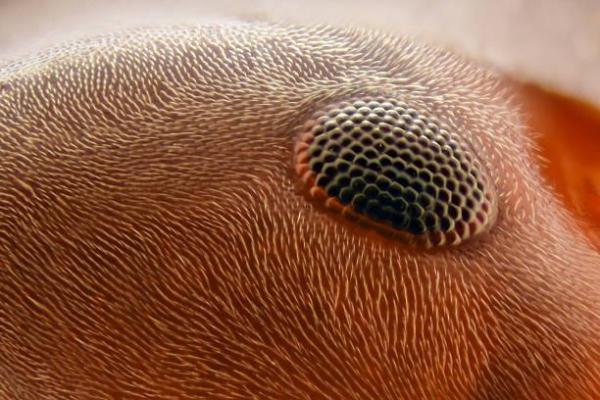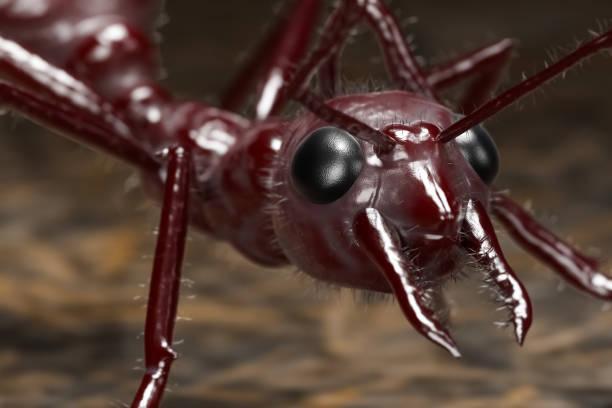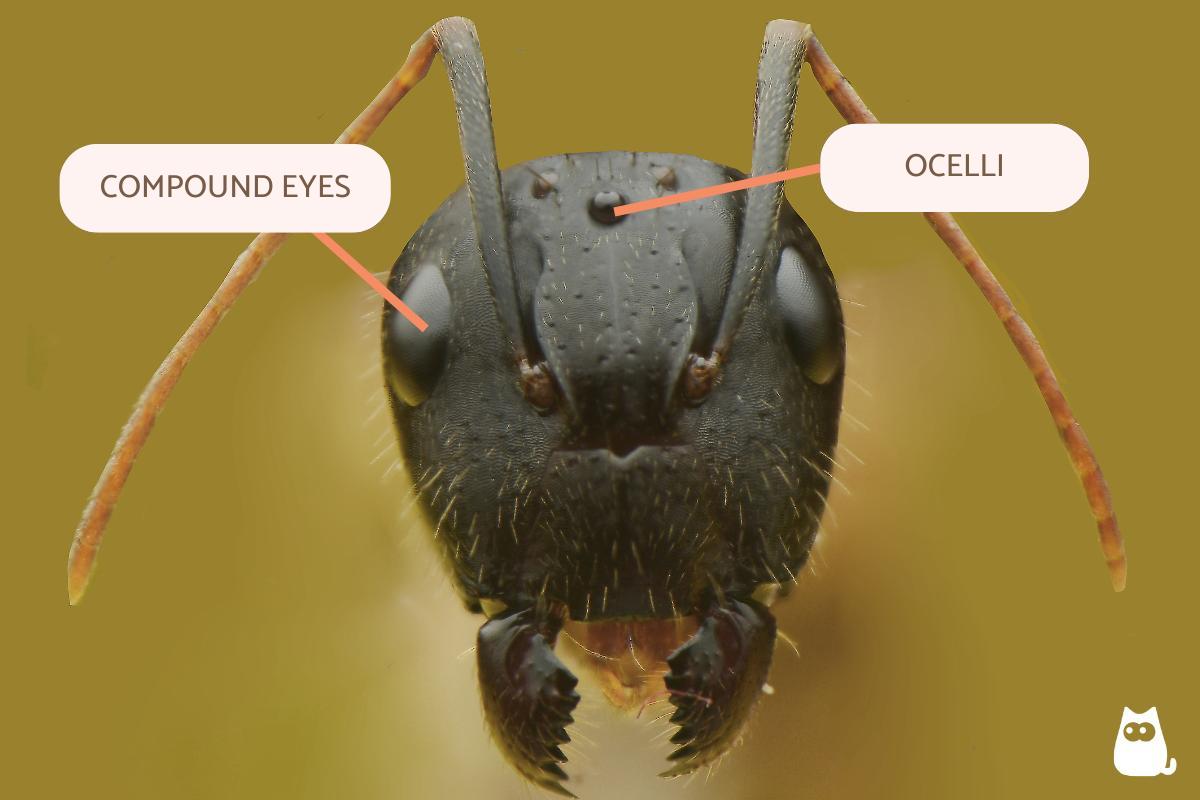Do Ants Have Eyes?


Ants are known for their incredible ability to source food and carry it long distances. If you have every seen one pick up some crumbs, you will have noticed they often seem to scurry about. Looking closely, you will see their antennae constantly moving to receive information from their environment. These antennae can detect changes in temperature, air currents, vibrations and even chemicals. With such acute non-visual sensory appendages, we may think that ants have no need for eyes. This is why AnimalWised asks do ants have eyes?
Most ants do have eyes. They use them to interpret stimuli in their environment, but they are not very acute. For this reason, ant vision is fairly limited. We explain more about ant vision and how these insects are so best able to navigate so well.
Do ants have compound eyes?
Most ants do indeed have compound eyes which they use to see. Despite this, their visual acuity is relatively poor and can vary greatly according to species. Compound eyes are made up of several individual units called ommatidia. These ommatidia function as tiny sensors of light and motion. Instead of forming a complete, clear image like the human eye, compound eyes create a more fragmented and pixelated vision. Each ommatidium takes in a small part of the visual field, providing the ant with a basic picture of its surroundings once each unit is composited.
Although almost all ants have eyes, not all species use them equally effectively. Arguably, some ants are even functionally blind. This is so in many ant species, such as those living underground or in dark habitats. Ant vision has diminished because it is not necessary for their survival. Other ants that live in brighter environments and forage above ground have developed better vision, although it is still quite limited compared to that of other insects.
Some ants have evolved to be completely eyeless. These are mainly subterranean ant species which have no need for vision since no light penetrates their environment.
Discover more about ant anatomy with our article on the body parts of ants.

How many eyes do ants have?
Most ants have five eyes in total. These include two large compound eyes and three ocelli (simple eyes) on the top of the head. These two different types of ant eyes help to explain ant vision:
- Compound eyes: ants have two compound eyes located on the sides of their heads. Each compound eye is made up of multiple ommatidia, which are small units that capture a portion of the visual field. This gives them a fragmented image of their surroundings.
- Ocelli: in addition to compound eyes, many ant species have three ocelli. These are simple eyes located in a triangle on the top of the head. Ocelli are not used for seeing detailed images, but rather sensing the amount of light in their environment. This helps with orientation and regulating the daily cycle.
Some species live in dark environments, such as underground tunnels. They may have reduced vision or no eyes at all. They rely more on other senses, such as smell and touch. Ocelli are also not as prominent in all types of ants in the same colony. For example, queens and mating males might need to use them during mating behaviors, but most worker ants will not have need for them. Ocelli are generally more common in winged ant species.
You can learn more about ant reproductive behavior with our article asking how are ants born?

Any eye anatomy
Ants have a pair of compound eyes, each made up of a set of tiny units called ommatidia. These are photoreceptor units which combined make up the compound eye. Each ommatidium has a hexagonal face known as a facet which takes in a fragment of the visual field. These fragments provide the ant with mosaic vision when composited. This is ideal for detecting movement in their environment.
The number of ommatidia an ant has varies by species. Some hunting species may have hundreds of facets in each eye. Other species have fewer ommatidia and therefore less precise vision.
Ant vision is not as detailed as that of humans, but it is very effective at distinguishing shadows, movements and differences in light. This is particularly useful for species that orient themselves while gathering food or hunting in open terrain.
In addition to compound eyes, many ants also possess three ocelli. These are simple eyes located on the top of the head. Ocelli do not form detailed images. Their main function is to detect changes in light intensity, which helps ants adjust their orientation and perceive the time of day. These ocelli are especially important in ants that live in environments where the light is constantly changing, such as outdoors or in forested areas.
Ants that spend most of their lives in dark tunnels, such as some subterranean species, have less developed or even absent compound eyes. This is because they do not need vision to navigate. For these ants, the senses of smell and touch are much more important than sight. The use of antennae for chemical and other stimuli detection are also vital in navigation.
With reduced sight, ants cannot rely on vision alone to send information. Learn more about how they are able to do so with our article asking how do ants communicate?

How do ants see?
We have seen that most ants are not blind, but their vision is generally poor. Ants have a way of seeing that is quite different from humans. Having compound eyes, their vision is fragmented and mosaic. Each ommatidium captures only a small part of the visual field and the sum of these partial images allows the ant to have a perception of the environment. This gives them a blurry vision without details, but with a high sensitivity to movement. This is useful for detecting possible predators or food sources.
There are large variations in ant vision. Worker ants and those living in open areas tend to have more developed eyes and better vision. They need to move over long distances and detect prey or landmarks. Ants living in underground colonies or in dark environments have reduced eyes or no eyes at all. They rely more on their senses of smell and touch to move and communicate.
What color do ants see?
Although most ants see in black and white, some species have the ability to detect ultraviolet light. This allows them to distinguish certain contrasts that humans cannot perceive. This type of vision is useful for detecting visual cues in the natural environment and can help them orient themselves using light and shadow markings.
Now that you know that ants have eyes and what they look like, you may want to also know whether ants can sting or bite.
If you want to read similar articles to Do Ants Have Eyes?, we recommend you visit our Facts about the animal kingdom category.
- Aksoy, V., & Camlitepe, Y. (2018). Spectral sensitivities of ants–a review. Animal Biology, 68(1), 55-73.
- Jelley, C., & Barden, P. (2021). Vision-linked traits associated with antenna size and foraging ecology across ants. Insect Systematics and Diversity, 5(5), 9.
- Menzi, U. (1987). Visual adaptation in nocturnal and diurnal ants. Journal of Comparative Physiology A, 160, 11-21.
- Yilmaz, A., Aksoy, V., Camlitepe, Y., & Giurfa, M. (2014). Eye structure, activity rhythms, and visually-driven behavior are tuned to visual niche in ants. Frontiers in Behavioral Neuroscience, 8, 205.








